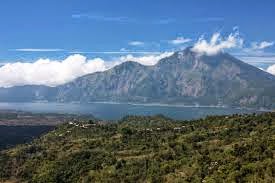The geography of Indonesia is covered with volcanoes.
 | |
| Indonesian Landscape
http://balianyartour.com/batur-lake-and-batur-volcanokintamani-bali-indonesia/image-4/
|
 |
|
Indo-Australian and Erusian Plates
http://www.savu-raijua.com/geology.htm
|
These volcanoes
have formed from subduction zones that have formed between the Indo-Australian
plate and the Eruasian plate. Some
Indonesian volcanoes are still active and erupting. The Indo-Australian plate is moving forward
which is causing it to slide under the Eurasian plate. The Indo-Australian
plate is moving at a fairly constant speed of 1mm per year, but there is a rare
occasion when the plate may slide at a great rate. This causes an earthquake
which can affect the country’s volcanoes (Savu-Raijua).
 |
|
Eruption of Mount Sinabung
http://www.cbc.ca/news/world/indonesia-s-mount-sinabung-erupts-forcing-6-000-to-flee-1.1855595 |
Indonesia has the most active volcanoes of any
country with over 130 active volcanoes. The
volcanoes are mostly located along the Indonesian island arc system. This is on an arc of the plates that are
primarily located on the islands of Java and Sumatra (Geology.sdsu.edu).
 |
|
Indonesian Island Arc System
http://www.geology.sdsu.edu/how_volcanoes_work/Krakatau.html
|
This arc, known as the Sunda Arc, is over 3000 km from NW Sumatra to the Banda Sea. The arc is formed by the subduction of Indian Ocean crust that lies beneath the Asian plate. The volcanoes on either end of the arc are more complex as the plates on the ends are more complex (Smithsonian Institution).
Works Cited
Associated Press. "Indonesia's Mount Sinaburg Erupts,
Forcing 6,000 to Flee." CBC News.
N.p.,
16 Sept. 2013. Web. 12 Oct. 2014.
Bali Anyar Tour and Travel. "Batur Lake and Batur
Volcano, Kintamani Bali-Indonesia." Bali
Anyar Tour and Travel.
N.p., n.d. Web. 12 Oct. 2014.
Geology.sdsu.edu. "How Volcanoes Work Krakatau,
Indonesia." Geology.sdsu.edu. N.p.,
n.d. Web.
Savu-Raijua. "Tectonic Evolution of Savu." Savu Raijua.
N.p., n.d. Web. 12 Oct. 2014.
Smithsonian Institution. "Indonesia." Smithsonian
Institution National Museum of Natural
History Global Volcanism Program. N.p., 2013.
Web. 12 Oct. 2014.
No comments:
Post a Comment